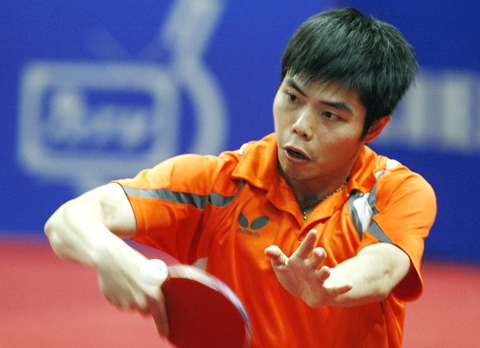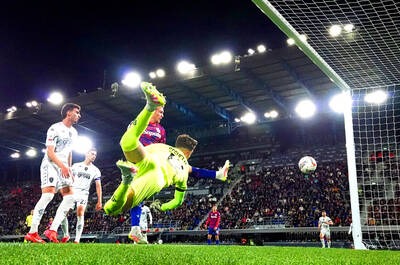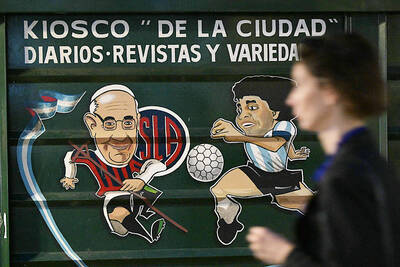Risks of birth defects, nervous system and lung problems brought about the end of the “speed glue” era in table tennis and next month’s world championships will be the first without it for over 30 years.
The International Table Tennis Federation (ITTF) banned the substances from Sept. 1 last year, or just after China’s clean sweep of gold medals on home soil in the Beijing Olympics.
That means the elite table tennis scene at the Yokohama world event from April 28 to May 5 will have changed markedly compared with previous championships. Speed glue, first discovered by Hungary’s Tibor Klampar more than 30 years ago, revolutionized the game, increasing spin and speed by up to 30 percent and making powerful shots easier to play.

PHOTO: AP
Yet there was a darker side. While the game became a better spectacle because of powerful shotmaking, harrowing incidents started the warning bells ringing. A player at the Scottish championships collapsed after his glue can fell over and he inhaled all the fumes.
Some athletes had nervous system-related disorders such as severe headaches, concentration problems and poor awareness.
German table tennis magazine Deutsche Tischtennissport even reported a pharmacist stating there had been at least five instances of birth defects in newborn babies after skin contact with toluene, one of the toxic solvents in the first generation of speed glues.
Former French national team doctor Christian Palierne, who carried out major research into the consequences of speed gluing, told Deutsche Tischtennissport: “It has been proved beyond doubt that inhaling solvents during the speed gluing process has side effects. The coaches must ask themselves whether they really can be answerable for allowing 11 to 13-year-olds to use speed glue.”
Still, these claims were the extreme end of the spectrum and on a day-to-day level, health-related problems were rare.
Yet in December 1992, the ITTF banned speed gluing.
Players organization CTTP, led by Sweden’s 1991 world champion Jorgen Persson, said the decision was too drastic and too close to the 1993 world championships in Gothenburg, Sweden.
The 1992 Olympic champion Jan-Ove Waldner was also concerned the ban would simply bring about cheating. Two months after the ruling, the ITTF rescinded the ban and instead found a compromise whereby dangerous glues, containing the most dangerous toxic substances such as toluene and trichlorethylene, were made unavailable through control of the market.
The glues were weaker, meaning players had to put on more and more coats of it to get the same speed and spin-boosting effect, often just prior to each international match.
ITTF president Adham Sharara said the repeal of the speed glue ban in 1993 was a mistake and that the decision to ban it in September last year would stay.
“There’s no going back,” he said. “We’ve made enough compromises and the end of the Olympic Games in China spells the end of speed gluing. It would be irresponsible to ignore all the reports about the danger of certain chemicals in our society and in our sport.”

Bologna on Thursday advanced past Empoli to reach their first Coppa Italia final in more than half a century. Thijs Dallinga’s 87th-minute header earned Bologna a 2-1 win and his side advanced 5-1 on aggregate. Giovanni Fabbian opened the scoring for Bologna with a header seven minutes in. Then Viktor Kovalenko equalized for Empoli in the 30th minute by turning in a rebound to finish off a counterattack. Bologna won the first leg 3-0. In the May 14 final in Rome, Bologna are to face AC Milan, who eliminated city rivals Inter 4-1 on aggregate following a 3-0 win on Wednesday. Bologna last reached the

If the Wild finally break through and win their first playoff series in a decade, Minnesota’s top line likely will be the reason. They were all over the Golden Knights through the first two games of their NHL Western Conference quarter-finals series, which was 1-1 going back to Minnesota for Game 3 today. The Wild tied the series with a 5-2 win on Tuesday. Matt Boldy had three goals and an assist in the first two games, while Kirill Kaprizov produced two goals and three assists. Joel Eriksson Ek, who centers the line, has yet to get on the scoresheet. “I think the biggest

From a commemorative jersey to a stadium in his name, Argentine soccer organizers are planning a slew of tributes to their late “Captain” Pope Francis, eulogized as the ultimate team player. Tributes to the Argentine pontiff, a lifelong lover of the game, who died on Monday at the age of 88, have been peppered with soccer metaphors in his homeland. “Francisco. What a player,” the Argentine Football Federation (AFA) said, describing the first pope from Latin America and the southern hemisphere as a generational talent who “never hogged the ball” and who showed the world “the importance of having an Argentine captain,

Noelvi Marte on Sunday had seven RBIs and hit his first career grand slam with a drive off infielder Jorge Mateo, while Austin Wynn had a career-high six RBIs as the Cincinnati Reds scored their most runs in 26 years in a 24-2 rout of the Baltimore Orioles. Marte finished with five hits, including his eighth-inning homer off Mateo. Wynn hit a three-run homer in the ninth off catcher Gary Sanchez. Cincinnati scored its most runs since a 24-12 win against the Colorado Rockies on May 19, 1999, and finished with 25 hits. Baltimore allowed its most runs since a 30-3 loss to